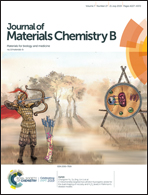An electrospun fibrous platform for visualizing the critical pH point inducing tooth demineralization†
Abstract
Dental caries is one of the most prevalent human oral diseases. The pH of the oral environment is lower than the critical pH point, which causes the demineralization of the hard tissues of teeth and finally leads to dental caries. Therefore, it is important to have an accurate, sensitive detecting assay of the critical pH. An electrospun fibrous membrane was reported to modulate immobilized bromocresol green (BCG), a common pH indicator, by shifting the acid dissociation constant (pKa) from 4.6 to 5.3. Based on spectroscopic and colorimetric characterizations, it was demonstrated that the BCG–polystyrene/polyvinylpyrrolidone (BCG–PS/PVP) electrospun fibrous membrane achieved a sensitive and fast response; moreover, its use exhibits a convenient sensing strategy for visualizing the critical pH point of 5.5 that induces tooth demineralization. Compared with a common pH meter or pH test papers, the BCG–PS/PVP electrospun fibrous membrane could distinguish pH 5.5 from its adjacent pH value with higher accuracy and much more convenience. We could also evaluate the inhibitory effect of the anti-caries agents on bacterial growth and acid production by the platform. The BCG–PS/PVP electrospun fibrous membrane is expected to have potential applications in the monitoring and prevention of early caries.



 Please wait while we load your content...
Please wait while we load your content...